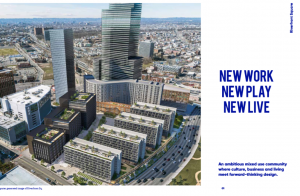A central question posed in the aftermath of George Floyd’s death is how far will cities go to assure equitable distribution of the benefits of new development. Newark, where Mayor Ras Barka has made inclusionary growth the cornerstone of his administration, offers a case in point.
In 2019 a limited liability company based in New York City announced a hugely ambitious plan for redeveloping the site where the Newark Bears minor league baseball team used to play. Located in the heart of the Irnonbound district, the project promised to extend the revitalization of the city core, in association especially with the New Jersey Performing Arts Center and the Prudential Arena across the tracks from Penn Station. Touting its Riverfront Square project on its website as “twelve acres of transit-oriented work-focused, bold play, and enhanced living,” Lotus Equity Partners aimed its marketing at younger, whiter consumers, noting that there were 800,000 millennials residing within 45 minutes of the proposed development.. As I circulated the draft of the chapter of my book, The Paradox of Urban Revitalization, I was warned that the project might well not happen. Try as I did, I could not get a confirmation one way or the other, but considering the project an important addition to other downtown investments, I included a description in the book.

Riverfront Square
After the book went to press Newark announced that the original investors had been replaced with another development team. Renamed CitySquare, the new plan calls for 4,200 apartment units to be spread among three, 37-story towers, plus another eight buildings that will be roughly half that size. There will be 100,000 square feet of commercial space, and 2,000 underground parking spaces. Most importantly, the revised development falls under the city’s new inclusionary zoning ordinance and will now incorporate five percent of the units in onsite affordable housing and a $15 million payment to the City Affordable Housing Trust Fund to produce new housing in neighborhoods outside the downtown. Five percent of on-site units represent about 200 units, and some residents have complained that the number is not a big jump toward Baraka’s goal of creating 6,000 new affordable units throughout the city by 2024. Confirming the challenge of meeting that goal has been the release of a new Rutgers study demonstrating a rapid rise in corporate purchases of housing for rent, a process that promises to make housing more expensive. In a city where the great majority of families rent and 35 percent are already paying more than 30 percent of their income for housing, the phenomenon is especially troubling. Certainly, Baraka has set worthy goals for inclusionary growth, and it’s now worth watching how well he is able to achieve them.